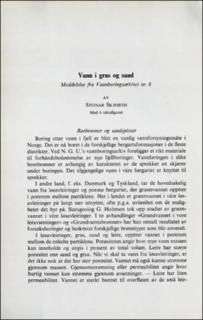| dc.contributor.author | Skjeseth, Steinar | |
| dc.coverage.spatial | 18172 Lillehammer | |
| dc.coverage.spatial | 19152 Ullensaker | |
| dc.coverage.spatial | LILLEHAMMER | |
| dc.coverage.spatial | ULLENSAKER | |
| dc.coverage.spatial | VIKEN | |
| dc.coverage.spatial | INNLANDET | |
| dc.date.accessioned | 2020-08-26T12:48:34Z | |
| dc.date.available | 2020-08-26T12:48:34Z | |
| dc.date.issued | 1958 | |
| dc.identifier.uri | https://hdl.handle.net/11250/2674681 | |
| dc.description.abstract | Every year about 600 drilled wells are carried out in Norway. The wells are with a few exeptions rock-wells. The ground water in the Quaternary porous and permeable deposits is not effectively utilized. Till now only 15 wells are drilled in these deposits. The results obtained are promising both as to quality and quantity of the water. The gravel and sand deposits in valleys covered by sea after last Ice age (Skjeseth, 1957, fig. 7) and the glacifluvial deposits above this sea level, give favourable conditions for well-construction. Fig. 5 shows the geology at a drilled well in alluvial deposits at Romerrike, south of lake Mjøsa. A well (brønn) in an alluvial cone at Lillehammer (fig. 6) is placed in an abandoned stream channel. | |
| dc.language.iso | nor | |
| dc.relation.ispartofseries | NGU (203) | |
| dc.rights | Navngivelse 4.0 Internasjonal | |
| dc.rights.uri | http://creativecommons.org/licenses/by/4.0/deed.no | |
| dc.subject | SAND | |
| dc.subject | GRUNNVANNSBRØNN | |
| dc.subject | RØRBRØNN | |
| dc.subject | GRUNNVANN | |
| dc.subject | AVSETNING | |
| dc.subject | GRUS | |
| dc.title | Vann i grus og sand. Meddelelse fra Vannboringsarkivet nr. 6. | |
| dc.type | Journal article | |
| dc.description.localcode | 35023 | |
| dc.source.pagenumber | 80-87 | |

